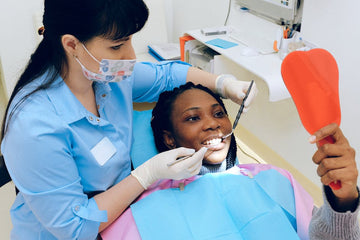Importance of cleaning medical equipment
Properly cleaning medical equipment is of utmost importance to ensure the safety and well-being of patients. Not only does it help prevent the spread of infections and diseases, but it also maintains the equipment's functionality and prolongs its lifespan. Many people may not realize that medical equipment can harbor harmful bacteria, viruses, and other pathogens if not cleaned and sanitized regularly. By following proper cleaning protocols, healthcare professionals can effectively remove contaminants and maintain a sterile environment. Additionally, regular cleaning can prevent cross-contamination between patients and reduce the risk of healthcare-associated infections. Overall, understanding the importance of cleaning medical equipment is crucial in providing quality care and maintaining a safe healthcare environment.

Basic cleaning supplies needed
Having the right cleaning supplies is essential for properly cleaning your medical equipment. While it may seem straightforward, there are specific supplies that are necessary to ensure a thorough and effective cleaning process. Some basic cleaning supplies you will need include disinfectant wipes or solution, cleaning brushes, gloves, and a cleaning agent suitable for the type of equipment you are cleaning. It is important to choose cleaning supplies that are compatible with the materials of your medical equipment and that meet the necessary safety and hygiene standards. By using the appropriate cleaning supplies, you can maintain the cleanliness and longevity of your medical equipment, ultimately ensuring the safety and well-being of both patients and healthcare providers.
Preparing the equipment for cleaning
Preparing the equipment for cleaning is a critical step in properly maintaining and ensuring the effectiveness of your medical equipment. Before starting the cleaning process, it is important to remove any visible dirt or debris from the equipment. This can be done by wiping down the surfaces with a damp cloth or using a vacuum to remove dust particles. Additionally, it is essential to disassemble any removable parts and clean them separately to ensure a thorough cleaning. By properly preparing the equipment for cleaning, you can help prevent the spread of infections and ensure the longevity of your medical equipment.
Cleaning techniques for different types of medical equipment
Cleaning medical equipment is of utmost importance to prevent the spread of infections and maintain the safety of patients and healthcare professionals. Different types of medical equipment require specific cleaning techniques to ensure their effectiveness and longevity. For example, surgical instruments should be thoroughly cleaned and sterilized using high-pressure steam or chemical disinfectants. Electronic equipment, such as EKG machines or ultrasound probes, should be cleaned with alcohol wipes or disinfectant sprays that are safe for electronic components. It is crucial to follow manufacturer guidelines and protocols to ensure proper cleaning and disinfection, as improper techniques can compromise the integrity of the equipment and put patients at risk.
Disinfecting the equipment
Disinfecting the equipment is a critical step in properly cleaning medical equipment. It is essential to eliminate any potentially harmful pathogens that may be present on the equipment's surface. By using appropriate disinfectants and following proper disinfection protocols, you can ensure that the equipment is safe for use in medical settings. Regular disinfection not only helps prevent the spread of infections but also extends the lifespan of the equipment, reducing the need for frequent replacements. It is important to stay updated on the latest disinfection guidelines and techniques to maintain a clean and sterile healthcare environment.
Drying and storing the equipment
Drying and storing your medical equipment properly is of utmost importance in maintaining its cleanliness and functionality. After cleaning, it is crucial to ensure that all equipment is thoroughly dried to prevent the growth of bacteria and other pathogens. Moisture left on the equipment can lead to contamination and compromise the effectiveness of the equipment. Additionally, proper storage is essential to protect the equipment from damage and maintain its sterility. Storing equipment in a clean and organized manner not only extends its lifespan but also ensures that it is readily available and in optimal condition when needed. By following these steps, you can ensure that your medical equipment remains clean, safe, and ready for use.
Special considerations for sensitive equipment
When it comes to cleaning medical equipment, special considerations must be taken into account for sensitive equipment. These pieces of equipment are often delicate and require extra care to ensure their functionality and longevity. One important tip is to use gentle cleaning agents that are specifically designed for sensitive materials, such as alcohol wipes or mild detergents. Additionally, it is crucial to follow the manufacturer's instructions for cleaning and disinfecting, as certain equipment may have specific requirements. Regular maintenance and inspections are also vital to identify any signs of wear or damage that may compromise the equipment's performance. By following these special considerations, healthcare professionals can effectively clean and maintain their sensitive medical equipment, ensuring the highest level of safety and quality of care.
Frequency of cleaning medical equipment
Regular and thorough cleaning of medical equipment is of utmost importance to ensure the safety and well-being of both patients and healthcare professionals. However, the frequency of cleaning medical equipment can vary depending on the specific item and its intended use. While some equipment may need to be cleaned after each use, others may only require cleaning on a weekly or monthly basis. It is crucial to follow the manufacturer's guidelines and any applicable industry regulations when determining the frequency of cleaning. Additionally, it is essential to implement a systematic cleaning schedule and use appropriate cleaning agents to effectively remove any contaminants and maintain the equipment's functionality and longevity.
Tips for maintaining the cleanliness of medical equipment
Maintaining the cleanliness of medical equipment is of utmost importance to ensure the safety and well-being of patients. Regular cleaning and disinfection not only prevent the spread of harmful bacteria and viruses but also extend the lifespan of the equipment. One essential tip is to always refer to the manufacturer's guidelines for cleaning and disinfecting procedures, as different equipment may require specific methods. Additionally, using the appropriate cleaning agents and disinfectants is crucial to effectively remove any contaminants without causing damage. Proper storage and handling of the equipment also play a significant role in maintaining cleanliness. By following these tips and incorporating a thorough cleaning routine, healthcare professionals can provide a sterile and safe environment for their patients.
Summary and final thoughts
Properly cleaning your medical equipment is of utmost importance in maintaining a safe and sterile environment. It not only ensures the wellbeing of patients but also prevents the spread of infections. It is crucial to follow a systematic approach while cleaning medical equipment, starting with proper hand hygiene and using the appropriate cleaning agents. Regularly disinfecting and sterilizing the equipment is essential to eliminate any potential pathogens. Additionally, it is vital to establish a routine maintenance schedule to keep the equipment in optimal working condition. By prioritizing cleanliness and adhering to best practices, healthcare professionals can guarantee the safety and effectiveness of their medical equipment.



